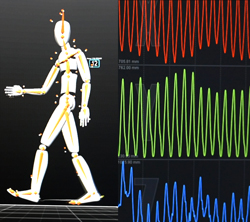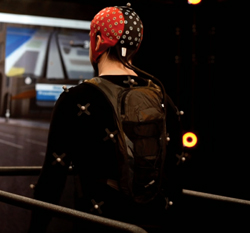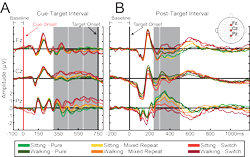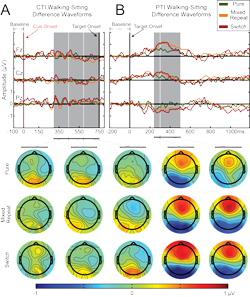Selected Publications
 Neural Markers of Proactive and Reactive Cognitive Control Are Altered During Walking: A Mobile Brain-Body Imaging (MoBI) study
Neural Markers of Proactive and Reactive Cognitive Control Are Altered During Walking: A Mobile Brain-Body Imaging (MoBI) study
Richardson DP, Foxe JJ, Mazurek KA, Abraham N, Freedman EG - NeuroImage. 2021 Dec 23.
 When an individual attempts to walk and perform a mental task simultaneously, the brain must manage distribution of resources between processes directing either movement through the environment, or planning and execution of the task. If priorities change, or competition for the brain’s resources exceeds the supply, disruptions to these processes may occur (Cognitive-Motor Interference), causing unstable gait or poor performance on the cognitive task. Declining performance on a cognitive task could stem from walking interfering with either preparations made before the task is performed, or processes which occur as the task is being carried out.
When an individual attempts to walk and perform a mental task simultaneously, the brain must manage distribution of resources between processes directing either movement through the environment, or planning and execution of the task. If priorities change, or competition for the brain’s resources exceeds the supply, disruptions to these processes may occur (Cognitive-Motor Interference), causing unstable gait or poor performance on the cognitive task. Declining performance on a cognitive task could stem from walking interfering with either preparations made before the task is performed, or processes which occur as the task is being carried out.
 To compare the effects of walking on preparatory processes and brain activity as a task is carried out, twenty-two young adult participants completed a task-switching experiment. On each trial of the experiment cues instructed participants to prepare for one of two possible tasks. Next, participants were required to compare two images projected on a screen in front of them. The correct response on each trial depended on which of the two tasks was being performed. The task was easier when participants needed to repeatedly make the same type of comparison, and harder when they were required to switch between the two different tasks from one trial to the next. As participants repeatedly performed trials while sitting or walking, their brain activity and movements were monitored using Mobile Brain and Body Imaging (MoBI), a technology which pairs electroencephalography (EEG) with motion capture.
To compare the effects of walking on preparatory processes and brain activity as a task is carried out, twenty-two young adult participants completed a task-switching experiment. On each trial of the experiment cues instructed participants to prepare for one of two possible tasks. Next, participants were required to compare two images projected on a screen in front of them. The correct response on each trial depended on which of the two tasks was being performed. The task was easier when participants needed to repeatedly make the same type of comparison, and harder when they were required to switch between the two different tasks from one trial to the next. As participants repeatedly performed trials while sitting or walking, their brain activity and movements were monitored using Mobile Brain and Body Imaging (MoBI), a technology which pairs electroencephalography (EEG) with motion capture.
 Although walking progressively changed participants’ brain activity underlying both task preparation and execution as task difficulty increased, neither task performance, nor gait suffered. Rather, participants adapted to walking and performing the task simultaneously, with gait consistency and stability actually improving. Overall this suggests the brains of these healthy young adults flexibly matched the supply of resources for cognitive and motor processes to the increases in demands. It also suggests there may be surprising benefits to performing cognitive and motor processes simultaneously within the range of an individual’s adaptive capacity. Understanding the limits of this range, and how it changes with the normal effects of aging, or the abnormal effects of disease, may also provide new measures to track brain health in the clinic.
Although walking progressively changed participants’ brain activity underlying both task preparation and execution as task difficulty increased, neither task performance, nor gait suffered. Rather, participants adapted to walking and performing the task simultaneously, with gait consistency and stability actually improving. Overall this suggests the brains of these healthy young adults flexibly matched the supply of resources for cognitive and motor processes to the increases in demands. It also suggests there may be surprising benefits to performing cognitive and motor processes simultaneously within the range of an individual’s adaptive capacity. Understanding the limits of this range, and how it changes with the normal effects of aging, or the abnormal effects of disease, may also provide new measures to track brain health in the clinic.